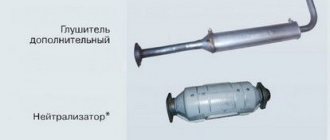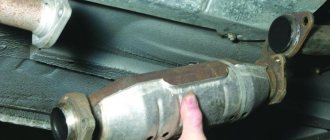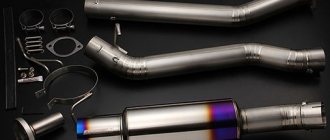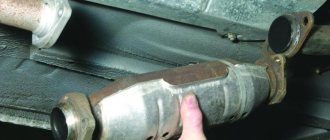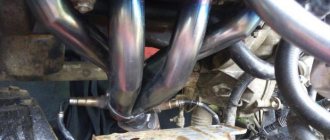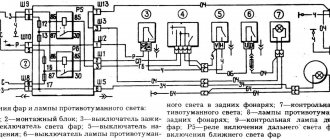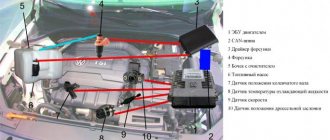Published: 10/30/2020
- Main elements of the exhaust system
- Choosing a resonator for VAZ 2107
- Resonator
- Location of the VAZ 2107 resonator
- Muffler VAZ 2106
- Lada 2107, 241 thousand without capital › Logbook › Replacing the VAZ-2107i injector resonator
- Basic moments
- How are knocking and muffler position related?
- Exhaust system design of VAZ 2107
- What is a muffler for?
- Differences between the exhaust systems of carburetor and injection VAZ models
- Volkswagen Jetta Chocolate shark › Logbook › Self-oil change in DSG-7 1.4 (122). Report.
- Roger Shah meets Aly & Fila and Susana – Unbreakable
- How often does a muffler need to be repaired?
- Car engine noise - elimination principle
- Symptoms of a clogged muffler
Exhaust system design of VAZ 2107
Like most passenger cars, the VAZ 2107 has an exhaust system consisting of three main parts:
- a receiving pipe into which gases enter from the exhaust manifolds;
- VAZ 2107 resonator (additional muffler), where gases are directed from the exhaust pipe and where the exhaust sound is partially reduced;
- muffler, which absorbs most of the engine exhaust noise.
In addition to the above parts, the exhaust system includes:
- muffler mounting pad;
- pillow bolt;
- muffler suspension belt;
- clamp bolt and clamp securing the muffler to the resonator;
- clamp bolt and clamp securing the resonator to the exhaust pipe;
- clamp bolt and clamp securing the exhaust pipe to the body;
- nuts securing the exhaust pipe to the manifold;
- pad;
- locking plate;
Design and operation of the exhaust tract
Car exhaust system. types and features
The exhaust system includes 3 main elements (starting from the power unit):
- double exhaust pipe, in driver's jargon - “pants”;
- middle section equipped with one or two resonator tanks;
- the last section is the main muffler.
3 sections of the exhaust system are connected using clamps.
The number of resonators in the middle part of the tract depends on the type of engine installed on the VAZ 2107. If the car was equipped with a 2105 engine with a working volume of 1.3 liters, 1 tank was provided per section (modification of VAZ 21072). Cars with 1.5 and 1.6 liter power units (VAZ 2107-21074) were equipped with pipes for 2 resonators.
The length of the element is the same for all carburetor modifications of the VAZ 2107, but on cars with more powerful 1.5 and 1.6 liter engines, 2 resonator banks are provided
On a VAZ 2107 with a 2105 engine, it is not advisable to install a section with 2 tanks - this reduces the power of the power unit. Dreaming of quiet operation of the 1.3 liter engine, I personally tried to change the 1-tank resonator to a 2-tank one. I didn’t notice a decrease in the exhaust sound, but I clearly felt a drop in traction under load.
The entire tract is attached at 5 points:
- the flange of the “pants” is screwed to the outlet manifold with 4 bronze M8 nuts;
- the end of the exhaust pipe is attached to the bracket on the gearbox;
- the flat muffler tank is hooked by 2 rubber hangers;
- The muffler outlet pipe is fixed with a rubber cushion screwed to a metal body bracket.
The principle of operation of the tract is quite simple: the gases pushed out by the pistons pass through the manifold and “pants”, then enter the resonator section. There, preliminary suppression of sound vibrations and a decrease in temperature occur, after which the combustion products enter the main muffler. The latter reduces the noise level as much as possible and releases gases to the outside. Heat transfer and cooling of the smoke occurs along the entire length of the exhaust elements.
On the injection “seven”, the gases undergo additional purification in the catalyst
On “sevens” with an injector, the exhaust design is supplemented with a catalytic converter and oxygen sensors. The element is located between the receiving pipe and the second section, the connection method is flange. The catalyst cleans flue gases from toxic compounds (nitrogen oxide and carbon), and lambda probes inform the electronic control unit about the completeness of fuel combustion based on the free oxygen content.
Differences between the exhaust systems of carburetor and injection VAZ models
Installation of an injection system on a VAZ 2107 required modernization of the exhaust system. Two additional details were added to it:
- an oxygen sensor that determines the composition of the mixture, which is embedded in the exhaust manifold;
- an exhaust gas catalyst (“catalyst”), which is installed in front of the resonator, in the central tunnel under the bottom.
In connection with the installation of the catalyst, the VAZ 2107 resonator (injector) was moved a little back.
The new exhaust system has become a little more complicated, but it allows for a reduction in the toxicity of the VAZ 2107 exhaust and ensures that the car complies with EURO-2 standards.
Advantages and disadvantages of the injection modification of the VAZ 2107
The “Seven” in injection version and with a modernized exhaust system has a number of advantages over the old “carburetor” model. They are as follows:
- thanks to the injector, the engine operates more stable in all modes;
- the specific power and torque of the injection engine are higher;
- the exhaust of a VAZ 2107 with an injection system is cleaner than smoke from a carburetor engine;
- Driving a car with an injection engine is easier, it is not so demanding on the driver’s qualifications and “forgiven” mistakes when operating the gas and clutch pedals.
But installing the injector at the same time worsened some performance characteristics:
- the clearance of the injection “seven” decreased to 7 cm, which worsened its cross-country ability;
- due to the installation of the catalyst, the “survivability” of the exhaust system has decreased;
- the high temperature of the catalyst sometimes causes grass and dry leaves to ignite when the car is stopped.
Main advantages of the updated model
The modernized version of the VAZ 2107, which has an injector and an improved exhaust, has a number of advantages. The main advantages of the machine are as follows;
- The injector ensures high stability of engine parameters in different operating modes.
- The injection system increases specific power and torque, which adds dynamism to the car.
- During operation, the car's power unit produces less toxic emissions of CO and other compounds than its carburetor counterparts.
Exhaust system functions and parts replacement intervals
Despite its apparent simplicity, the exhaust system performs several important functions:
- removal of fuel combustion products;
- reduction of noise level from the exhaust;
- maintaining air balance in intake and exhaust systems;
- ensuring ventilation and cleaning of cylinders;
- reduction of CO content (in the presence of a catalyst).
Exposure to high temperatures, moisture, fuel and oil combustion products leads to through corrosion of exhaust system parts. This is aggravated by the external influence of gravel, sand and salt solutions that are used to treat roads in winter. Therefore, parts of the system have to be changed. The frequency of replacement depends on the following factors:
- car use activity;
- frequency of machine operation in bad weather (rain, snow);
- fuel quality;
- quality of exhaust system parts.
Purpose and design of the resonator
The structure of the resonator is similar to a direct-flow muffler - a perforated pipe is laid inside the cylindrical body without any partitions. The difference lies in the jumper that divides the jar into 2 resonator chambers. The element performs 3 functions:
- perceives and pre-damps sound waves;
- dissipates part of the heat coming from combustion products;
- Extends the service life of the main muffler.
Unlike direct flow, the resonator does not absorb, but repeatedly reflects sound vibrations
When operating, a two-chamber tank uses the principle of resonance - sound vibrations are repeatedly reflected from the walls, collide with oncoming waves and cancel each other out. The VAZ 2104 was equipped with 3 types of sections:
- Cars with a carburetor power system were equipped with a long resonator for 2 tanks. For the modification with a 1.3 liter VAZ 2105 engine, an element with 1 can was installed.
- Models with an injector, produced under Euro 2 environmental standards, were equipped with a shorter resonator with 1 tank. The inlet pipe began with a flange, which was fastened with two bolts to the mating part of the neutralizer.
- On modifications of VAZ 21043 and 21041, “tailored” to Euro 3 requirements, the shortest resonator was used, equipped with a mounting flange for 3 studs.
Damage and malfunction of the resonator cans are similar to the main muffler section. During operation, housings and pipes burn out, rust or break due to external influences. The repair methods are identical - welding, temporary bandage or complete replacement of the part.
Video: how to replace the resonator on classic VAZ models
Over the years, it has become more difficult to find high-quality spare parts for domestic cars that have long been out of production. Practice shows that it is better to repeatedly repair the original factory muffler than to buy a part of unknown origin that will literally fall apart after 10 thousand km. The second reliable option is to incur financial costs, but install a durable stainless steel exhaust pipe.
Replacing the muffler VAZ 2107
The VAZ 2107 muffler (injector and carburetor) is connected to the resonator with a clamp, which is located in front of the rear axle. Before removing the clamp, it should be tapped with a hammer to make it easier to unscrew the threaded connection and uncouple the pipes. To change the muffler, you need to do the following:
- loosen the clamp bolt and remove (move) the clamp;
- pull the flared muffler pipe off the resonator (if that doesn’t work, knock it down with a hammer and chisel);
- remove the muffler from the cushion and mounting straps;
- install a new muffler on the VAZ 2107;
- tighten the clamp.
Replacing the VAZ 2107 resonator
The VAZ 2107 resonator does not have fastening parts to the car body, so it is necessary to hold it when replacing it. Otherwise the exhaust pipe will be bent.
The replacement work consists of the following steps:
- tap clamps and pipe connections with a hammer;
- loosen the bolts of the clamps and move the clamps fastening to the “pants” and the muffler;
- disconnect the resonator from the muffler by undocking the pipes;
- disconnect the resonator from the receiving pipe (“pants”);
- install the new resonator in the correct position;
- connect the parts and tighten the fastening clamps.
Note: the resonator tank must be parallel to the ground, otherwise the part will knock on the bottom of the car and cling to uneven road surfaces.
Replacing the exhaust pipe (“pants”) of a VAZ 2107
When replacing the exhaust pipe, be sure to replace the gasket between it and the exhaust manifold. It is also better to change the nuts securing the “pants” to the manifold. The procedure is as follows:
- loosen the clamp and disconnect the pants from the resonator;
- unscrew the four nuts securing the exhaust pipe to the manifold;
Important: unscrew the nuts carefully so as not to twist the fastening studs. Otherwise, you will have to drill out and replace the studs.
- remove the “pants” (exhaust pipe) and gasket;
- install a new gasket;
- install a new exhaust pipe;
- connect the exhaust pipe to the resonator, tighten the fastening clamp;
- tighten the nuts securing the “pants” to the manifold.
If, after installing a new exhaust pipe, the exhaust system sags or hits the bottom, the following options are possible:
- the resonator or exhaust pipe is fixed at the wrong angles;
- engine mounts sagged.
In the first case, it is enough to loosen the clamps and install the parts correctly. In the second case, the engine mounts will have to be replaced.
Main muffler - device and types
The factory-made element is made of refractory “black” steel and coated with a layer of anti-corrosion paint. The part consists of 3 parts:
- front pipe, curved to bypass the rear axle;
- three-chamber muffler tank with a system of partitions and pipes inside;
- outlet pipe with a bracket for mounting a rubber cushion.
The original Zhiguli mufflers are made of refractory steel with anti-corrosion protection.
The mufflers sold today for the “classics” are not reliable - spare parts are often made of second-rate metal and burn out after 15-25 thousand kilometers. It is quite difficult to identify a low-quality part when purchasing; the only way is to visually check the quality of the welds.
In addition to the factory version, other types of mufflers can be installed on the VAZ 2104:
- element completely welded from stainless steel;
- sports (direct-flow) option;
- a homemade section with a round cistern made from a thin-walled iron pipe.
Factory forward flow is externally distinguished by the shape of the body, heat-resistant black coating and a decorative nozzle instead of a regular pipe
A stainless steel exhaust element will cost 2-3 times more than a factory part, but can last up to 100 thousand km. I was convinced of this personally when I bought and installed a stainless exhaust system on my VAZ 2106 - the design is identical to the exhaust tract of the V4. I happily forgot about the pipe burnouts for several years.
The direct-flow type of muffler differs from the standard part in its operating principle. Gases pass through the perforated pipe and do not change the direction of movement, the resistance of the section is zero. Result: it is easier for the engine to “breathe”, but the noise is suppressed less well - the operation of the motor is accompanied by a rumbling sound.
The main difference between forward flow is the minimal resistance to the passage of gases, which gives an increase of 3-5 liters. With. to engine power
If you are “friendly” with a welding machine, the factory version of the muffler can be modified or the element can be made from scratch. In home-made products, the principle of direct flow is implemented, since welding a flat tank with partitions is much more difficult - it is easier to buy a ready-made part. How to make a main muffler with your own hands:
- Select pipes for the outer casing and direct-flow channel. As a tank, you can use a round muffler from a Tavria, or take a curved front pipe from an old section from a Zhiguli.
- Make an internal perforated pipe by drilling holes Ø5-6 mm and making through slots with a thin circle on the metal.
Perforation in the form of holes and slits is performed to allow the passage and further absorption of sound vibrations - Insert the pipe into the casing, weld the end caps and external connecting pipes.
- Fill the cavity between the tank body and the direct-flow channel with non-flammable kaolin wool or basalt fiber.
It is better to use non-flammable kaolin wool or basalt fiber as a noise absorber - Seal the casing cover by welding and install 3 eyes for rubber hangers.
The final stage of manufacturing is painting the part with a heat-resistant composition. After installing any muffler - factory or homemade - the protruding end of the pipe can be refined using a decorative nozzle, fixed from the outside with a locking screw.
Exhaust System Mounting Parts
The clamps and suspension elements of the exhaust system are exposed to moisture and salt during machine operation. In addition to corrosion, metal “fatigue” accumulates in clamps. The clamps begin to loosely hold the connection, as a result of which exhaust gases begin to break out, creating noise. Old suspension cushions may break off, which can damage exhaust system parts. Therefore, it is advisable to change the mounting parts; whenever large parts are replaced, the mounting elements on which they are attached should also be changed. This will avoid unnecessary problems and expenses.
Over time, the exhaust system of the VAZ 2107 fails and the owner has to go to a service station or change it himself. In the latter case, you will need a standard tool and an inspection hole. You may also need a grinder and WD-40.
How the VAZ 2101-2107 exhaust system works and works, repairs and modifications
The exhaust system of a car has a special function - to remove waste gases from the engine. As you know, fuel after combustion leaves gases that must be completely released. The faster and better this process takes place, the higher the efficiency of the power unit. The gases first move in the direction of the exhaust pipe of the VAZ-2107 exhaust system, and then exit through the muffler. A hermetic seal is placed between the exhaust manifold of the internal combustion engine and the exhaust pipe, which prevents leakage of exhaust gas under the hood of the car. In some cases, instead of a gasket, corrugation is used to reduce vibrations. However, installing it is already a matter of tuning, adjusting all other elements of the system to the required parameters.
What's in the exhaust system?
The exhaust of the “seven” consists of several main parts: the exhaust manifold, the exhaust pipe, the resonator and the muffler. In addition, there are additional elements: rubber fasteners, flanges, seals.
The VAZ-2107 exhaust system includes the following elements: 1. exhaust manifold gasket; 2. exhaust pipe (pants); 3. bracket for fastening to the gearbox; 4. clamps for connecting pipes; 5. front resonator (first additional muffler); 6. rear resonator (second additional muffler); 7. main muffler; 8. Rubber suspension mount or cushion.
Exhaust system VAZ-classic
Let's take a closer look at the main parts of the exhaust system.
An exhaust manifold made of good quality metal (sometimes replaced by tuners with steel.) This part of the exhaust system has the function of collecting exhaust gases. It is a unit of several cylinders or tubes. It is made on VAZ-2107 from cast iron. One side is attached to the exhaust pipe, the other to the engine. During operation of the machine, the exhaust manifold is subjected to heavy loads, since due to its design features it operates in extreme conditions. Gases tend to heat up to a temperature of a thousand degrees, and after stopping the engine, they cool sharply, which inevitably leads to the formation of condensation. Corrosion appears on the collector. Thus, the exhaust manifold is responsible for: • removing exhaust gases from the engine chambers; • for filling and purging the chambers.
The operation of the exhaust manifold is inextricably linked with resonance. During the operation of the engine - the combustion of the fuel-air mixture - strong pressure is generated, which is used to circulate gases. The pressure or pressure wave flows back into the cylinders, thereby helping the next portion of gases escape. The higher the engine speed, the more pressure is created and the faster the exhaust gases escape.
Downpipe
“Pants” - this name was given to this part for the characteristic shape of the exhaust pipe receiving gases coming from the engine exhaust manifold. The exhaust pipe is also an integral part of the exhaust system. It is located after the exhaust manifold, in front of the resonator. Made from durable metal, tuned models include corrugated parts. The receiving pipe of injection machines is different.
The exhaust pipe of the exhaust system is “pants”, this one is for carburetor cars
The “pants” on the VAZ-2107 quite often fail. This occurs mainly due to environmental influences. The same condensate formed as a result of temperature fluctuations negatively affects the metal components of the pipe. In addition, in winter in Russia, roads are sprinkled with compounds containing salts and various chemicals. They also have a bad effect on the exhaust pipe body. On the VAZ-2107, trousers are made from ferrous metal at the factory. However, you can independently replace the model with modernized analogues.
-The best choice is a receiving pipe made of stainless steel. It is, however, expensive. But there are a lot of advantages: resistance to corrosion and long service life. -Aluminized version of the pants. It is made of ordinary steel, but coated with aluminum. The service life of such products is more than five years (a standard pipe can burn out after two years). Additionally, they can be equipped with corrugated spacers.
Exhaust system design of VAZ 2107
- a receiving pipe into which gases enter from the exhaust manifolds;
- VAZ 2107 resonator (additional muffler), where gases are directed from the exhaust pipe and where the exhaust sound is partially reduced;
- muffler, which absorbs most of the engine exhaust noise.
- muffler mounting pad;
- pillow bolt;
- muffler suspension belt;
- clamp bolt and clamp securing the muffler to the resonator;
- clamp bolt and clamp securing the resonator to the exhaust pipe;
- clamp bolt and clamp securing the exhaust pipe to the body;
- nuts securing the exhaust pipe to the manifold;
- pad;
- locking plate;
Installation of an injection system on a VAZ 2107 required modernization of the exhaust system. Two additional details were added to it:
In connection with the installation of the catalyst, the VAZ 2107 resonator (injector) was moved a little back.
Advantages and disadvantages of the injection modification of the VAZ 2107
- thanks to the injector, the engine operates more stable in all modes;
- the specific power and torque of the injection engine are higher;
- the exhaust of a VAZ 2107 with an injection system is cleaner than smoke from a carburetor engine;
- Driving a car with an injection engine is easier, it is not so demanding on the driver’s qualifications and “forgiving” mistakes when operating the gas and clutch pedals.
- the clearance of the injection "seven" decreased to 7 cm, which worsened its cross-country ability;
- due to the installation of the catalyst, the “survivability” of the exhaust system has decreased;
- the high temperature of the catalyst sometimes causes grass and dry leaves to ignite when the car is stopped.
What is important to know about the resonator
Structurally, the pre-muffler is identical to the forward flow described above - a straight perforated pipe passes through the cylindrical body.
The only difference is the partition that divides the tank space into 2 chambers. Resonator tasks:
- dampen primary sound vibrations of large amplitude;
- facilitate the work of the main muffler and extend its life;
- remove some of the heat from the flue gases.
The resonator bank resembles a forward flow, only the part size is smaller
The VAZ 2107 car is equipped with 3 types of resonators:
- The classic option for carburetor engines, used in the first models with an injector, is a long pipe with one or two banks (depending on engine size).
- On injection models that comply with Euro 2 exhaust standards, a shortened resonator section with a flange was installed at the front end of the pipe. The catalytic converter was bolted to it.
- After the introduction of Euro 3 standards, the length of the catalyst increased and the length of the resonator decreased. The section for the injection version of the “seven”, which meets these requirements, is equipped with a front flange with 3 bolts.
When operating resonators, the malfunctions described above occur - burnouts, rust and mechanical damage. Troubleshooting methods are similar to repairing a muffler - welding or temporary sealing with a bandage. Removing the resonator section is not difficult - you need to unscrew the fastening to the gearbox, then disconnect the muffler and “pants” pipes. On a VAZ 2107 with an injector, the flange is disconnected instead of the front clamp.
Video: how to remove the resonator VAZ 2101—2107
Since the classic Zhiguli models, including the VAZ 2107, have been discontinued, the problem of purchasing high-quality spare parts arises. The market is flooded with cheap mufflers that burn out after 10–15 thousand km. Hence the final conclusion: sometimes it is easier to contact a competent welder and eliminate the defect at low cost than to purchase a new part of dubious origin.
Replacing the muffler VAZ 2107
- loosen the clamp bolt and remove (move) the clamp;
The VAZ 2107 resonator does not have fastening parts to the car body, so it is necessary to hold it when replacing it. Otherwise the exhaust pipe will be bent.
- tap clamps and pipe connections with a hammer;
- loosen the bolts of the clamps and move the clamps fastening to the “pants” and the muffler;
- disconnect the resonator from the muffler by undocking the pipes;
- disconnect the resonator from the receiving pipe (“pants”);
- install the new resonator in the correct position;
- connect the parts and tighten the fastening clamps.
Replacing the exhaust pipe (“pants”) of a VAZ 2107
- loosen the clamp and disconnect the pants from the resonator;
- unscrew the four nuts securing the exhaust pipe to the manifold;
- remove the “pants” (reception pipe) and gasket;
- install a new gasket;
- install a new exhaust pipe;
- connect the exhaust pipe to the resonator, tighten the fastening clamp;
- tighten the nuts securing the “pants” to the manifold.
- the resonator or exhaust pipe is fixed at the wrong angles;
- engine mounts sagged.
When to change the resonator
The resonator of any car is an additional muffler that reduces the noise level of the engine. In addition to the main “can,” the resonator, or as it is also called, receiving pipe can be equipped with an additional one.
Ultimately, holes appear on the surface of the resonator, which disrupt its operation. Exhaust gases escape through these defects, creating an unpleasant sound of the engine, which is not only unpleasant to others, but will certainly not leave traffic inspectors indifferent. That is why a damaged resonator must be replaced immediately.
To change the resonator, you need to stock up on all the necessary keys, kerosene or WD-40, as well as a lot of patience and accuracy. The fact is that high temperatures cause the exhaust pipe fasteners to melt, which subsequently makes it difficult to remove. In addition, you will need an inspection hole or overpass, otherwise changing the resonator will be very inconvenient.
Many automotive technicians suggest applying sealant before installing the exhaust system. Whether to do it or not is up to you. In any case, the reliability of fastening and sealing the exhaust system is limited only by the force that the clamp allows you to make.
As some drivers joke, the muffler is one of those parts that “does not affect speed.” Indeed, getting to the garage without a muffler, if that happens, is acceptable. But everyday comfortable and safe operation of a car is impossible without this important design element.
The difference between a direct-flow muffler and a conventional one
The diagram shows that the direct-flow muffler does not have transverse partitions. The standard muffler consists of a rather complex system of pipes and grilles in which noise is dampened. Parts of the exhaust system on a modern car also include a lambda probe, a catalytic converter, and an exhaust gas temperature sensor. Thus, a standard muffler compared to a forward flow muffler is a slightly more complex system.
The standard muffler consists of a complex system of pipes and grilles
Direct-flow muffler device
For proper tuning of the exhaust system, it is advisable to install a different, improved exhaust manifold in combination with forward flow, remove the catalyst and install a receiving pipe of increased diameter. After all, in a tuned exhaust system, all obstacles that stand in the way of exhaust gases have been removed.
A straight-through muffler is made so that its throughput is higher than that of a standard muffler, and it more freely removes exhaust gases from the engine. As a result of such tuning, cylinder purging improves, less carbon deposits on the pistons and valves, which, in turn, increases the life of the power unit. Its power increases by about 15%.
A related factor is a slight deterioration - compared to the standard muffler - in noise indicators
The straight-through muffler has a harsh roar that can attract the attention of the traffic police, cause a fine or anger neighbors when a tuned car revs up under their windows early in the morning.
When installing an improved exhaust system, these factors should also be taken into account, otherwise tuning may cause pointless costs in the future. The absence of internal partitions and noise-absorbing padding makes direct flow relatively simple to manufacture.
This is interesting: Why a car is removed from warranty
Standard and direct-flow mufflers with remote “labyrinth” and noise absorbers
What does direct flow give?
A significant improvement in the power performance of a car with the installation of a direct-flow muffler occurs when the power unit is fully operational, maintains normal compression, is little worn, and even better - if any of its components have been modified. Thus, forward flow will increase power if the cylinder head, the intake system have been tuned, or the cylinder block itself has been bored to a larger volume. If the car owner has not yet taken on serious modifications to the engine, but wants to spend money on exhaust tuning, then by doing so he will still increase the power of the power unit, receiving in addition a bass rumble, making the car a little more dynamic.
The filling of the cylinders with the air-fuel mixture depends on the nature of the exhaust gases. However, changing the sound in a “sporty” direction is sometimes enough for a car enthusiast, as it gives the car a certain style. It is worth moving on to any change in the design of a car with the utmost seriousness, since all systems and assemblies in it are interconnected. If you do not properly modify the exhaust system, you can end up with a very roaring car, the ride in which will become unbearable for both the driver and passengers.
Purpose and design of the muffler for VAZ 2104–2107 cars
Exhaust gases escape from the engine cylinders under high pressure and with loud noise. The muffler receives and slows down gases, converts their kinetic energy into thermal energy, smoothes out pulsations and muffles the sound, then releases the weakened exhaust into the atmosphere.
Thus, among the main functions of the muffler:
- reduction of engine noise;
- conversion of exhaust gas energy;
- safe release of gases into the atmosphere.
In everyday life, a muffler is called an exhaust tract or exhaust system. In fact, it is only one, albeit the most important, element of the fuel system. For VAZ cars with a classic layout, it consists of a reception pipe connected to the engine exhaust manifold, an additional (resonator) and a main muffler.
For VAZ cars with a classic layout, the exhaust gas system consists of a reception pipe connected to the engine exhaust manifold, an additional and main muffler
Purpose of the exhaust system
Before combustion in the engine cylinders, gasoline is mixed with air and supplied through the intake manifold into the combustion chamber. There, the mixture is compressed eight times by the pistons and ignited by a spark from the spark plug. As a result of the process, 3 components are formed:
- heat and mechanical energy that rotates the crankshaft;
- gasoline combustion products - carbon dioxide and carbon monoxide, nitrogen oxide and water vapor;
- combustion under high pressure generates sound vibrations - the same exhaust sound.
Since the efficiency of internal combustion engines does not exceed 45%, about half of the released energy is converted into heat. One part of the heat is removed by the engine cooling system, the second is carried out by the exhaust gases through the exhaust tract.
The smoke at the exit from the duct is cooled to a safe temperature, you can calmly raise your hand - it won’t burn you
The VAZ 2107 exhaust system performs several important functions:
- Emission of combustion products from the chambers and ventilation of the cylinders after the next combustion cycle.
- Reducing the amplitude of sound vibrations, that is, reducing the noise level of a running motor.
- Removal and dissipation of part of the released heat in the atmosphere.
On “sevens” with an injection power system, the exhaust tract solves another important task - it cleans the exhaust from toxic gases CO and NO by afterburning in a catalytic converter.
Replacement and repair of muffler for VAZ 2104–2107 cars
To replace the muffler you will need:
- inspection hole or lift;
- screwdriver;
- a set of car keys;
- hammer.
Removing and installing the muffler
To dismantle the “glushak”, repair it, and then return it to its place, follow this sequence of actions:
- Drive the car into the inspection hole. Stop the engine and turn off the ignition. Wait until the exhaust manifold cools down.
- Unbend the hooks of the rubber suspension straps of the muffler.
Using a screwdriver, straighten the hooks of the rubber straps on which the muffler is suspended
Unscrew the exhaust pipe fastening to the rubber cushion with a wrench
Loosen the clamp between the pipes of the main and additional muffler
Carefully knock the resonator out of the mount by hitting it with a hammer through a wooden spacer
Unscrew the exhaust pipe from the gearbox bracket
Carefully bend the stoppers and unscrew the exhaust pipe from the manifold
Install the new muffler in the opposite order of removal. However, do not use a used gasket. Before assembly, treat the pipes at the places where they are connected with clamps with graphite lubricant.
Video: replacing a VAZ 2107 muffler in a garage
In 1979, at VAZ, a car was built especially for “dear Leonid Ilyich,” which received the common name “half past six.” This happened after the presentation of the VAZ-2105 and 2107 models to the country's leadership, the serial production of which was still quite far away, and Brezhnev wished to give such a car to one of his family members. The result was a unique car, the body and interior of which was a hybrid of a “six” and a “seven” - hence the name.
Innokenty Kishkurno
Wheels
How to repair a muffler with your own hands
White smoke from the exhaust pipe, the main causes
Before you begin repairing the muffler, you need to evaluate the feasibility of these actions. Not every car owner has the skills to work with a welding machine. In addition, the muffler cannot always be properly repaired - in cases of severe burnout, it is best to immediately replace it with a new one.
Reasons for failure
Most often, mufflers on the VAZ 2106/2107 lose their functionality for the following reasons:
- mechanical damage while driving on uneven roads, impacts;
- rapid changes in temperature conditions, especially in winter, when it is cold outside, and inside the case there are very high temperatures due to exhaust;
- impurities in gasoline that come out along with exhaust gases and affect the condition of the metal surfaces of the muffler.
It is unsafe to operate a car with such damage to the muffler.
However, how urgently do you need to repair the muffler if you suddenly notice some damage to its body or black exhaust from the pipe? What are the dangers of operating a Zhiguli with a burnt out or deformed muffler?
Firstly, if there are holes in the body of any element, then the generated gases will enter the cabin. The main danger is that the exhaust is colorless and odorless and cannot be felt. In this case, the driver begins to experience headaches, nausea and dizziness. If you stay inside a car with the engine running for a long time, you can lose consciousness and even die.
Secondly, if the exhaust system does not work properly, engine power is reduced. This is especially noticeable when accelerating, starting from a standstill, or overtaking.
Thirdly, if the plug is faulty, the engine begins to consume a lot of gasoline. The carelessness of the car owner will lead to the fact that the muffler will work worse and worse, and the displacement per 100 km will increase.
How to weld a muffler
Most often, the muffler loses its tightness and therefore cannot work normally. In this case, holes can appear both on the pipes themselves and on the welds.
It is recommended to clean the weld seam and paint the work area with heat-resistant paint
Using a welding machine and metal patches can be considered the most reliable way to repair mufflers.
In order to weld a “muffler”, you need to prepare electrodes of a suitable size (it all depends on how large the hole is burned in the muffler) and a sheet of metal of the required size. After which it is recommended to carry out welding as far as possible from the edge of the holes, since the thinned edges of the metal can quickly collapse:
- Clean the torn edges of the muffler from rust and dust.
- Degrease the metal with a solvent.
- Apply a metal patch to the body and grab it in several places around the perimeter of the hole.
- After this, you can begin to apply full welds.
- After the seams have hardened, it is recommended to clean the slag with a wire brush.
It is recommended to apply welds carefully so as not to burn through the muffler body
How to change the gasket
There is a reinforced gasket between the main muffler and the resonator part. Its purpose is to prevent the resonator from heating, so it is made of heat-resistant metal.
After dismantling the muffler, it is recommended to change the gasket. This does not take much time, since the element is inserted into the muffler pipe and clamped between its parts.
How to replace hanging rubber bands
This is perhaps the simplest procedure in repairing Zhiguli mufflers. The rear part of the pipe is attached to the body with three hanging rubber bands. During the ride, some of them may get lost or seriously deformed.
To change these rubber bands, you just need to drive the car into an inspection hole or overpass, remove the old products and install new ones in their place. Some car owners change suspension rubber bands without an overpass, simply crawling under the body from the rear left side.
Video: changing the resonator and muffler on a VAZ 2106/2107 car
The muffler in classic VAZ cars cannot, of course, be called a durable element. However, it is up to the owner to carry out the necessary repairs in a timely manner or change the plug if necessary. Moreover, the procedure is simplified as much as possible by the design of the VAZ 2106/2107 themselves. Therefore, any work on the muffler can be done with your own hands in a garage.
How are knocking and muffler position related?
If the muffler suddenly starts knocking on some parts of the car, find the source of the extraneous sounds. Usually the reason lies in stretched rubber fasteners. After replacing them, the knocking will stop.
Sometimes a knock appears after work related to removing the muffler. In this case, extraneous sounds are a consequence of installation errors. Round pipes at the joints with clamps can be slightly rotated relative to the correct position: more or less than required, pushed into each other.
To eliminate knocking, restore the optimal position of the exhaust system elements.
Sagging mufflers can be “treated” using similar methods—by replacing rubber bands and correcting the position of joints.
Video: repairing a sagging VAZ 2106 muffler
The nuances of muffler repair
The muffler of “classic” VAZ cars, according to the manufacturer’s recommendations, cannot be repaired. If a malfunction occurs in any element of the exhaust tract, the part must be replaced with a new one.
In fact, motorists often prefer to repair holes burned in the muffler - the most common defect - by welding.
The occurrence of “fistulas” is indicated by a change in the sound of the engine and the appearance of smoke from under the car. To troubleshoot, place the machine on a platform and inspect the elements of the exhaust system.
If the cause is a burnt gasket, remove the muffler and replace it. When you have an assistant, you can do without removing all elements of the system. Proceed in the following order:
- Unscrew the pipe fastening to the gearbox.
- Unscrew the nuts securing the exhaust pipe to the manifold.
- Together with an assistant, pull the “pants” off the pins while simultaneously rotating the bend of the resonator pipe.
- Replace the gasket, install the pipe in place, tighten the fasteners.
Replacing a burnt muffler gasket eliminates extraneous sounds from the engine
A welded muffler usually lasts less than a new one. But welding is also cheaper than buying. Usually, if it is necessary to repair a muffler by welding, they turn to professionals. If you have the equipment, you can do the work yourself. For this you will need:
- welding machine;
- blanks for patches made of sheet metal 1–2 mm thick;
- a piece of pipe of the same diameter as the failed one;
- grinder with cutting disc for metal;
- metal brush;
- sandpaper;
- heat-resistant paint for metal.
To repair the muffler, follow this sequence:
- Remove the muffler from the vehicle.
- Using an external inspection, determine the location of the malfunction and the extent of the damage.
- If there is a large hole in the muffler body, evaluate the condition of the internal parts. It is possible that repairing the external surface will not bring the desired restoration of the functions of the muffler without replacing the internals. In this case, it is advisable to contact professionals or simply replace the faulty part with a new one.
- Cut out the burnt area. From the blank, make a patch larger than the damage. Weld the patch over the hole with a continuous seam.
- If there is damage at the junction of the pipe and the muffler body, cut out the defective area, replace the damaged part of the pipe, and weld the repaired pipe to the muffler with a continuous seam.
- Clean the repaired muffler from dirt and rust, paint the part with two layers of heat-resistant paint.
Photo gallery: muffler welding
Video: repairing a VAZ muffler by welding
Replacing and repairing a muffler is a dirty and time-consuming job. But there is nothing complicated about it. You never know what you can do till you try.
What is a muffler for?
Naturally, making the car sound quieter. Physically, the combustion of a mixture of air and gasoline produces vibrations of different frequencies, from low to high. The sound from the exhaust manifold carries all the energy of sound vibrations into the muffler, which is equipped with several special chambers. Like any wave, the sound from a motor has energy, or amplitude. The higher it is, the noisier the motor is. When it enters the chambers, the sound “gets entangled” and gives up its energy, turning into heat. This is why the muffler parts are so hot, although they are far from the engine, and the exhaust itself from the exhaust pipe is slightly warm. So, the first function is to make the engine quieter.
The second important function is the removal of combustion products, otherwise the mixture will not ignite in the zone of high carbon dioxide content.
The third function is keeping the cylinders clean and ventilating them.
It must be remembered that the exhaust system takes on very large thermal and chemical loads, and parts can “burn out”, since toxic exhaust gases, mixing with condensate, form complex acids, which are very aggressive at high temperatures.
On the outside, moisture, impacts from gravel, salt in winter and other causes also contribute to wear. Those who use their car in winter need to replace the muffler much more often.
What is the design of the VAZ 2107 muffler
The muffler is only part of the exhaust system. Its structure is as follows:
- Exhaust gases penetrate through the exhaust manifold into the so-called “pants” 12, which are called the exhaust pipe. The “pants” are separated from the exhaust manifold by a special gasket 11, which is designed to seal their fastening.
- The pipe is attached to the gearbox using bracket 15.
- Then there is a series of additional resonators, or mufflers, front and rear, which are attached using clamps 7 to the “pants” and 6 to the main muffler. These mufflers cut off certain sounds from high engine frequencies. Together they are called "additional muffler" 13.
- The main muffler (main) 3 is movably fixed to the bottom so that its frequency is not transmitted to the body. This mount can additionally dampen vibrations due to the “sway” of the muffler itself. It is produced using parts 1-4.
- Next comes the exhaust pipe.
Here it should be said that by the color of the exhaust and the condition of the pipe, one can draw certain conclusions about the operation of the engine, just as doctors draw conclusions about the work of the intestines by analyzing stool. For example, if you run your finger inside the pipe and a greasy, oily residue remains, then the oil scraper rings have become unusable and the engine “eats” oil, which is indicated by the black color of the exhaust. Normally, the inside surface of the exhaust pipe is dry.
The exhaust system assembly is shown below:
The main muffler contains numerous chambers consisting of perforated pipes.
The figure also shows the mounting pad and extensions of the main muffler. An important feature of the VAZ 2107 muffler is its complete “interchangeability” with the rest of the classics. If you purchase parts from a VAZ 2101, or any other modification, you will not go wrong.
If your muffler needs replacement, it is better to do this at a service center, and purchase spare parts there so that there is a guarantee for the installation. Simply replacing a muffler is a messy business, especially if you have to start from the “pants.” It is possible that you will need to cut off the stuck joints with a grinder.
A few words about sports modifications of the VAZ 2107 muffler
A conventional muffler is indirect, this increases the pressure in the exhaust manifold and can reduce engine power. At that time, a direct-flow, sports muffler filled with ceramic fiber is able to increase engine power by faster cleaning of the cylinders from exhaust gases. It should be said that the sports muffler of the direct-flow system will never “scream”, and the engine operating volume will be quite acceptable.
The exhaust system of classic VAZ models consists of three elements. The middle element is usually called a resonator. Any malfunction is accompanied by a roar coming from under the bottom of the car. Repairing and replacing the resonator with your own hands is quite simple. In this case, the choice of a new part becomes especially important - the manufacturer installed several types of resonators on the VAZ 2107, depending on the type of engine and power system.
